by Marcela M. | Aug 24, 2011 | Blog, Cakes, Parties, Recipe Box, Recipes, Sweets, Uncategorized

Good morning dear friends! I hope you are having a lovely week.
As I promised, here is the first post with the birthday cakes I prepared and decorated for my babies’3rd birthday (can I still call them babies? until they are 21?).
This year we decided to postpone their birthday party until November. We are travelling to Argentina for the first time since theywere born, so we thought that it would be a good opportunity to share this special moment with friends and family. We did have, anyway, a small family celebration : we filled the living room floor with balloons the night before, so that they would find them when waking up, and left their presents in their small table. And of course, there were cakes! Since it was just the four of us, the cakes were small , but I still thought it was important for each of them to have their own, and for the cakes to be decorated according to their personalities.
Both cakes had the same flavours: 2 layers of lemon cake, and 1 layer of chocolate cake, filled with 1 layer of blueberry jam and 1 layer of chocolate buttercream, and covered in fondant.

Luka’s cake was covered in green fondant and decorated with racing cars made with fondant. I made the racing cars the night before decorating the rest of the cake, to let them dry properly, following this tutorial from Cake Journal. I do not have all the instruments required so I had to be creative, for eg: in order to shape the car, I used a big knife and a fondant smoother (instead of two fondant smoothers), I used a lollipop stick to curve the car to make space for the head of the driver to sit in (instead of a ball tool), and instead of sugar glue, I used sugar syrup (=almibar).

In order to make the asphalt, I rolled black fondant, I placed the cake pan in which I had baked the cake on top of it, and I cut around it its perimeter with a pizza cutter. That gave me a circle of the exact same size as the top of the cake, but I didn’t want that much grass so, using the same pan to guide me, I cut a portion of the circle, creating a crease. I then placed the crescent moon on top of the cake, draw white lines in it with royal icing and glued the cars on top. I made grass with royal icing, using a #133 piping tip and added a few grains of green sugar sprinkles.
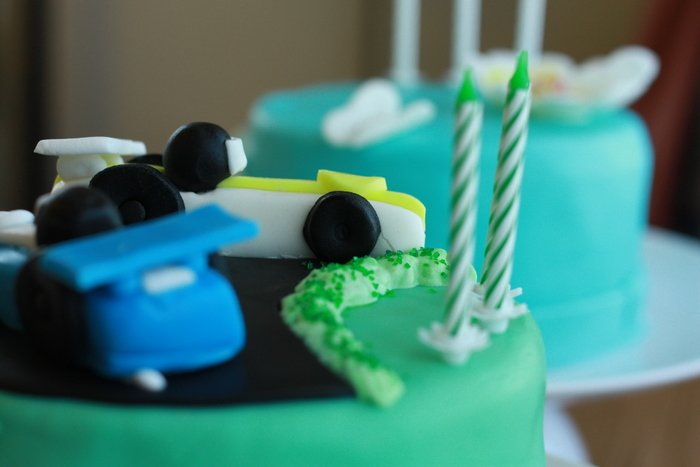
I covered the perimeter of the cake with tyres, made with the back of a #2D piping tip, and embossed in the center with a #10 tip. I also made two racing flags (I didn’t take a picture of them, sorry!) to put in front of the cake). One was yellow and white and the other one was black and white. To make them, I used a small square cookie cutter, and cut 1 white square, 1 black square and 1 yellow square. I then divided each square in four parts and mixed them to create the flags.
I finally added the candles, and that was all, the cake was ready!

As you can see it was a very easy cake, but Luka loved it. He was so excited about the cars, the candles and the wheels around it! He loves cars, trucks, trains, anything that has wheels in it. I was happy to see him happy.
In my next post I’ll show you Zoe’s cake, which was girly, like her.
Have a nice week!
by Marcela M. | Aug 17, 2011 | Blog, Recipe Box, Salads and dips, Savories, Uncategorized
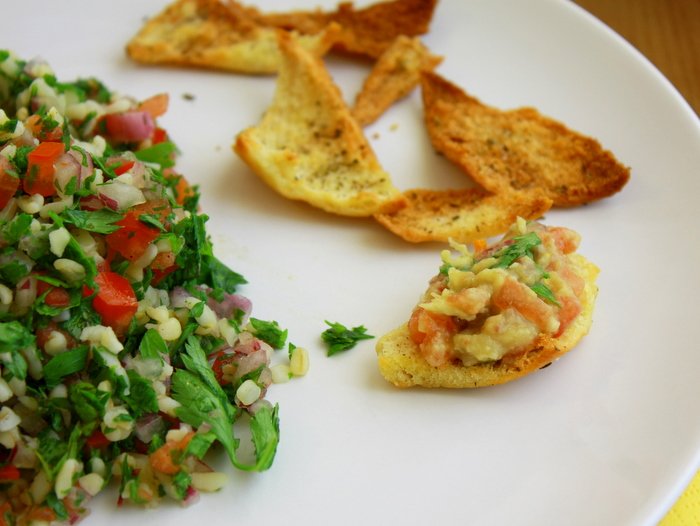
Good morning dear friends! How are you today? I hope you are all doing great.
I apologize for not posting last week. We had a very dear friend visiting us from abroad and we spent our days showing her around, and just enjoying her company. We had a great time, remembering good old times in Abidjan, Ivory Coast, where we all used to lived 4 years ago. Living outside of my home country has required a lot of adapting, and one of the things I have had to accept is having friends scattered all over the globe, and not being able to see them for long stretches of time. So, when we finally do meet, we try to squeeze time as much as we can and some other things fall behind.
But here I am again! Today, I am bringing you the rest of the recipes from our summer lunch, which consisted of tzatziki, guacamole, tabbouleh salad, crispy pitta bread slices and lemon coconut mousse for dessert. These are not my recipes, they are actually very common dishes, and I have read many different versions of each of them, but this is how I usually make them. They are ideal for this time of the year because they are fresh and simple, but I must confess that I LOVE tabbouleh all year-long.
I became a fan of Lebanese food in Abidjan, actually. Ivory Coast (and most of West Africa) has a large number of Lebanese people living in the country, and there are many Lebanese restaurants where one can try dishes such as tabbouleh, kebbeh, falafel, fatoush, etc. Tabbouleh was always one of my favourites and I would order it every time. I learnt how to make Guacamole from a recipe book, so my dear Amanda will have to tell me whether it’s a good one or not!

In order to make Guacamole you will need:
-1 ripe avocado, mashed
– 1/2 a tomato, peeled, de-seeded and cut in small cubes.
-1/2 garlic clove, crushed
– 1/2 red onion, finely diced
– Juice of 1/2 lime or lemon
– 1 teaspoon of olive oil
-salt and pepper to taste
– a few parsley leaves, to garnish.
Preparation is very simple:
1) Peel and mash the avocado with the lime/lemon juice.Put in a bowl.
2) Peel and de-seed the tomatoes. Dice them finely and add to the mashed avocado.
3) Peel and dice the onion, crush the garlic clove and add both to the avocado/tomato mixture.
4) Add olive oil, salt and pepper. Mix everything.
5) Chop a few parsley leaves and add to garnish. Serve.
Voilà!
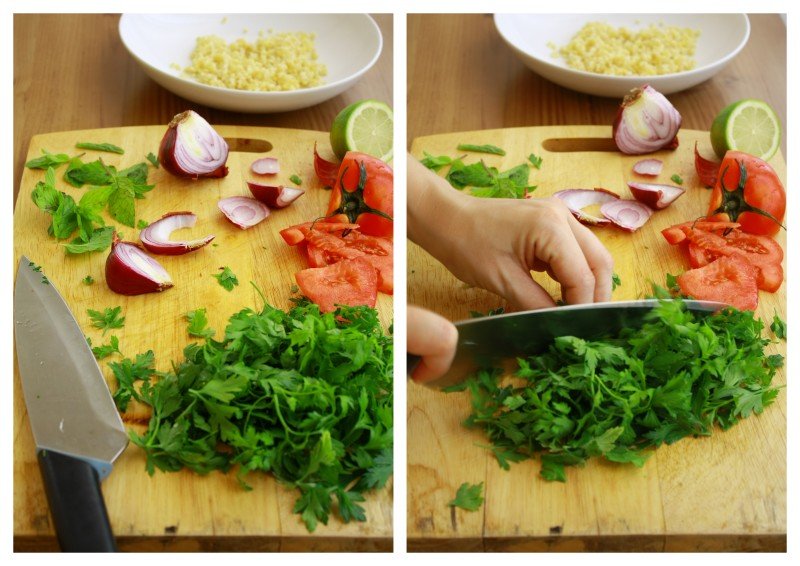
In order to make Tabbouleh, you will need:
-1 cup (a large bunch) of parsley leaves (you need only the leaves!)
– 1/3 cup of mint leaves
– 1/3 cup of bulgur wheat (If you have a gluten-free diet, you can replace it by Quinoa)
– 1 Tomato, finely diced
– 1/2 red onion
– Juice of 1/2 lime
– 1 teaspoon olive oil
– salt and pepper
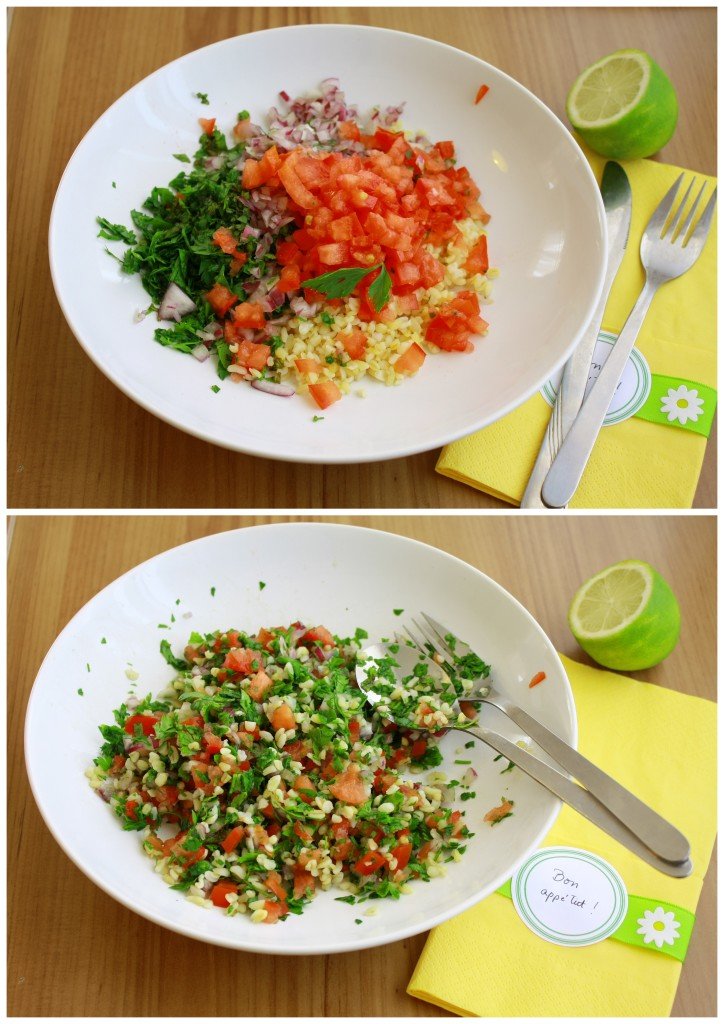
Preparation:
1)The first thing you need to do is wash and rinse the wheat twice. After you have done that, put it in a bowl and cover it with boiling water. Cover the bowl and let it sit for about 20 minutes, until the wheat absorbs the water.When the wheat is ready, put in a serving dish.
2) Using a knife, finely chop the parsley and mint leaves. I know it is tempting to use the food processor (if you have one) to chop all ingredients at once, but it changes the herb’s flavour, so do it the traditional way. Add the chopped leaves to the wheat.
3) Dice the tomatoes and the onion. Add to the rest of the ingredients.
4) Mix olive oil and lime juice. Add to the rest of the salad, together with salt and pepper to taste.
5) Toss all ingredients together several times. Serve.
Finally, I toasted some pitta bread in the oven with a drizzle of olive oil and oregano, and served the guacamole in them.
I simply cut one pitta bread into rectangles, then sliced it diagonally to form triangles. I put these slices in an oven tray covered with aluminium foil, drizzled them with olive oil, added salt and oregano and put them in the oven at 200 C for 5 minutes.
This is how they looked when they were done. They are very crispy, flavourful, and great for serving dips in them:
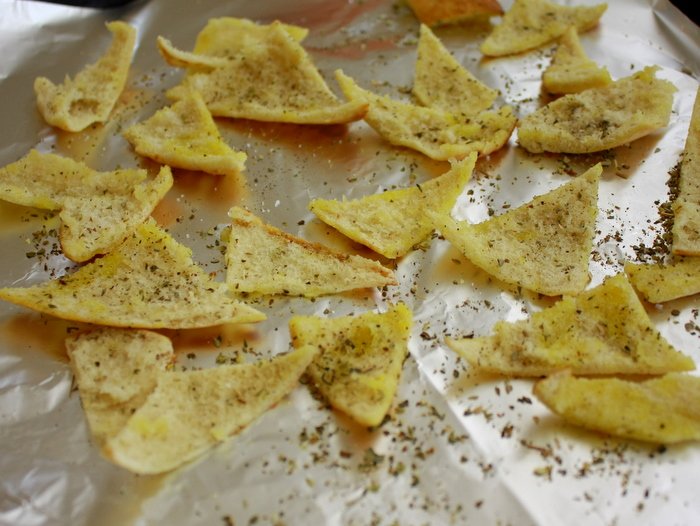
Have you had Tabbouleh and/or guacamole before? Dis you like them?
If you do like them, do you make your own at home too? Are your recipes similar to these ones or very different?
May you have a happy Wednesday. See you next week!
by Marcela M. | Aug 3, 2011 | Blog, Mousses and ice cream, Recipe Box, Recipes, Sweets, Uncategorized
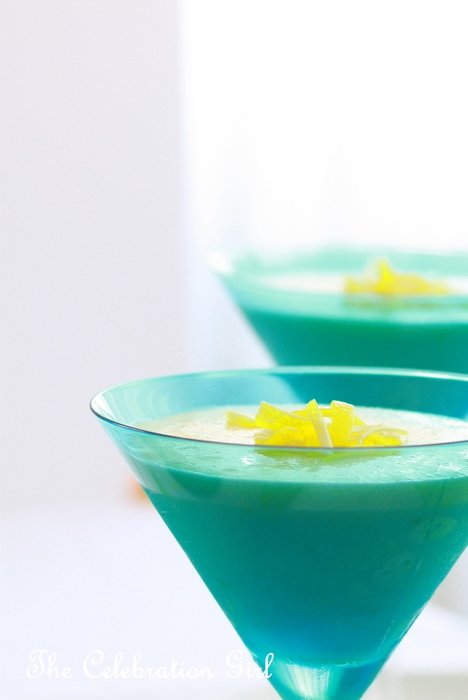
Happy Wednesday everyone! How are you today? How is this week going, so far? I hope you are all enjoying the warmth of Summer or the chilly days of winter, wherever you may be.
I had originally planned to bring you the recipes for the rest of the salads and dips that we had for our simple summer lunch, last week, but I received so many requests for the Lemon Coconut Mousse one that I decided to leave the salads for the next post. I guess my readers have a sweet tooth! 😉
This Lemon Coconut mousse was adapted from a recipe by Ina Garten and it’s easy to do even though it does take some time. Basically, I make my own lemon curd (with a recipe I had completely forgotten I had and I rediscovered when going through an old recipe notebook!) and I replace the sweetened whipped cream of her original recipe, by coconut cream (I find that the mousse is already sweet enough, and I like the addition of the subtle coconut flavor). I also doubled the amount of lemon zest because I like it very lemony.
In order to make this mousse you will need:
Ingredients:
For the Lemon Curd (serves two and half cups):
1 egg
2 egg yolks
zest and juice of 2 lemons
40 grs of butter
150 grs of sugar
2 tablespoons of cornstarch
250 ml of water
For the Lemon Custard:
3 XL whole eggs
3 XL egg yolks
1 cup of sugar
1/2 cup of lemon juice
4 teaspoons of lemon zest
a dash of salt
Additionally, to turn the custard into mousse:
3 egg whites, whipped into a firm meringue together with 2 tablespoons of sugar
1 cup coconut cream.
You can find coconut cream in the Asian food aisle of your supermarket, or you can simply put a can of unopened coconut milk in the fridge overnight. When you open the can, cream will have formed on top. Scoop it and add it to the rest of the preparation, it’s that easy!
1) The first thing to do when making this mousse is to prepare the Lemon Curd. I like to do this the day before, to make my life easier, but you can also do everything on the same day.
In order to make the lemon curd, put all ingredients in a pan and cook until it thickens, stirring constantly so that the cream doesn’t burn/sticks to the bottom of the pan. It will take about 6/7 minutes. Let it cool for about 15 minutes and then let it rest on the fridge.
2) The second step is to make the Lemon Custard. I know the original recipe says that the whole recipe takes a total 15 minutes preparation but, in my experience it takes double as much time just to get the custard ready. But from then on, it’s only a few extra minutes!
In order to make the custard, put all ingredients in a heat-proof bowl and put this one on top of a pan with simmering water. Let it cook, beating constantly with a whisk. After about 10 minutes it will start to thicken. Continue beating until it reaches pudding consistency (Argentinian friends: tiene que tener la textura de un postrecito). When it does, take the bowl off the heat and let it cool for about 15 minutes. Then, cover with plastic wrap and put in the fridge for 1-2 hours. When I make this mousse for a special occasion, I generally prepare both the Lemon Curd and the Lemon Custard the day before and let them sit in the fridge overnight.
After taking the custard out of the fridge it should look like this:

3) When the custard is ready, whip the egg whites until firm. Add the two tablespoons of sugar, one at a time, and continue beating until the meringue becomes glossy and firm.
4) Fold the egg whites carefully into the lemon custard with a spatula.
5) Add the coconut cream, making sure it incorporates evenly into the preparation.
6) Add 1 cup of Lemon Curd. Incorporate.
7) Put the Lemon Mousse in the fridge and chill for several hours. Serve and enjoy!
If you like lemony desserts, I am sure you will love this mousse: it is sweet and it has a wonderful, luscious texture.
In order to decorate it, I used just a few thin slices of lemon zest.

Would you like to have some?
I wish you a wonderful rest of the week and weekend. See you in a few days with a new post!
by Marcela M. | Jul 27, 2011 | Blog, Crafts and DIY, Parties, Recipe Box, Recipes, Salads and dips, Uncategorized
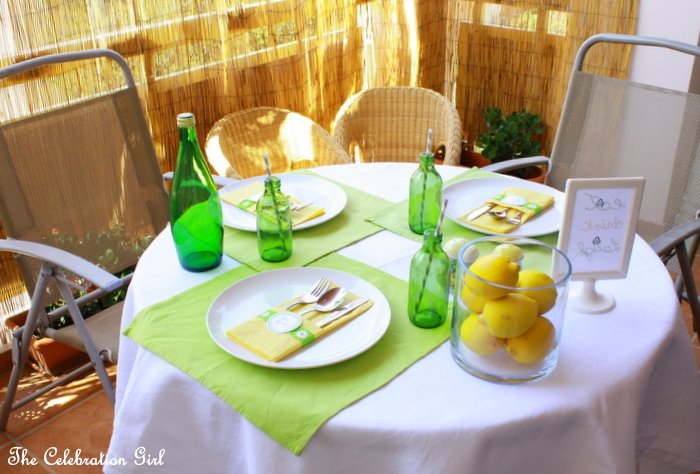
Summer in Cyprus is hot. Very. Hot. But this year it feels hotter due to the energy crisis caused by the destruction of the island’s main power plant. Things, however, are what they are and, I believe, it is for each of us to approach them with a positive attitude and make the best out of them. In my case, this means trying to add a little beauty to everyday life, and taking advantage of what we have.
We live in a apartment, so there is no garden or swimming pool where to spend our afternoons. What we do have is a small balcony which we have surrounded by a straw fence to keep the strong sun at bay, and where we can sit and relax, enjoying the sweet summer breeze when the sun is not too high. And, when weather permits it, we have lunch or dinner there too.
Last Monday, we did just that. It was not too hot (by our standards, anyway ;), so I set up a happy summery table setting and served a quick early lunch in the balcony.
I put a white tablecloth on the table, and used lime green napkins under the plates to add a little bit of colour.
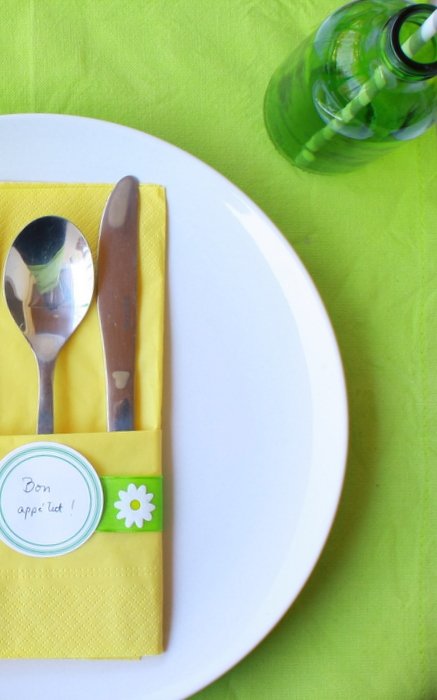
I put lemmons on a glass vase to serve as centerpiece, and used a set of salt and pepper shakers that we had bought when we lived in Ivory Coast and that matched the table’s colour palette.
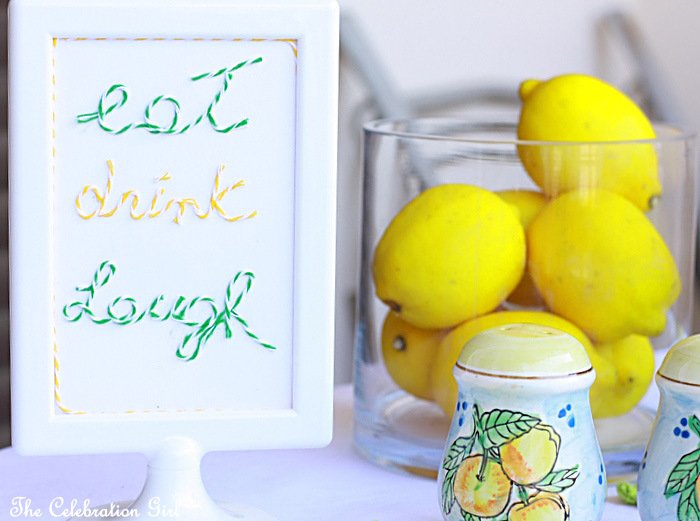
I served lemonade in small green bottles (that originally contained German beer!) and added grey paper straws to them for the babies. And also for me, because I like them 😉
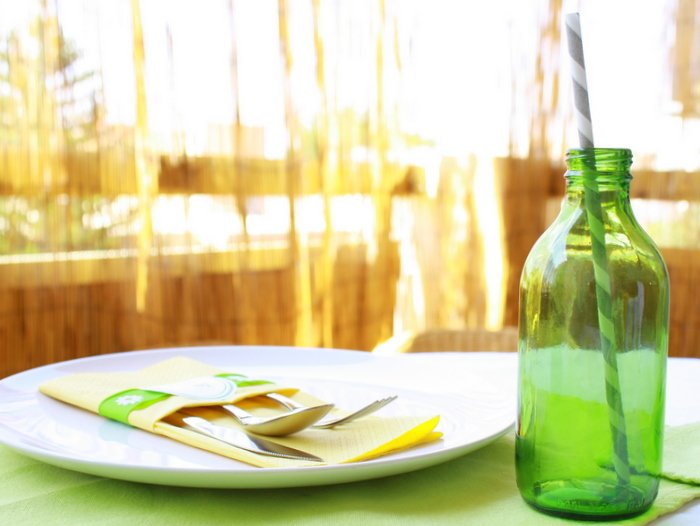
Using baker’s twine (in Peapod and Lemondrop, from the Twinery), I wrote “eat, drink, laugh” on a piece of paper and put it on a small frame, next to the lemons, to serve as motto for the meal.
Finally, I folded yellow paper napkins on a pouch, added some ribbon and a paper circle (with Bon Appétit written in it) to dress it up a little, and placed the cutlery inside . You can download these and other tags for free from the Twinery’s blog here. All you have to do then is to print them in cardboard paper and cut them using a 2″ circle punch or just a pair of scissors)
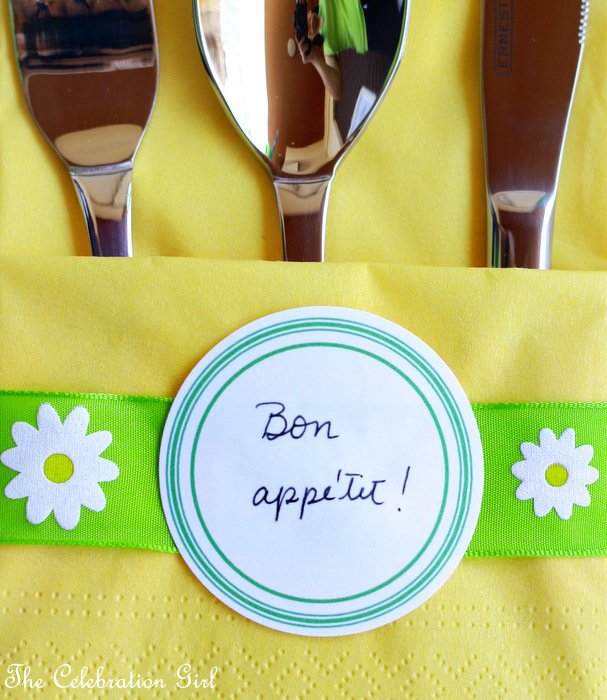
The menu consisted of different salads, dips and a delicious lemon coconut mousse. The following recipe corresponds to one of these salads, called Tzaziki, which is traditional here in Cyprus and which, with some variations, is also very common in Serbia (where I actually discovered it and where it is called Tarator ). It is very refreshing, simple to make, and it tastes great with meat or simply with some pitta bread. At home we call it “cucumber salad”. I’ll share all other recipes in my next post!
In order to make Tarator/Tzaziki you will need: 1 cucumber, 1 clove of garlic, greek yogurt and a little bit of parsley.
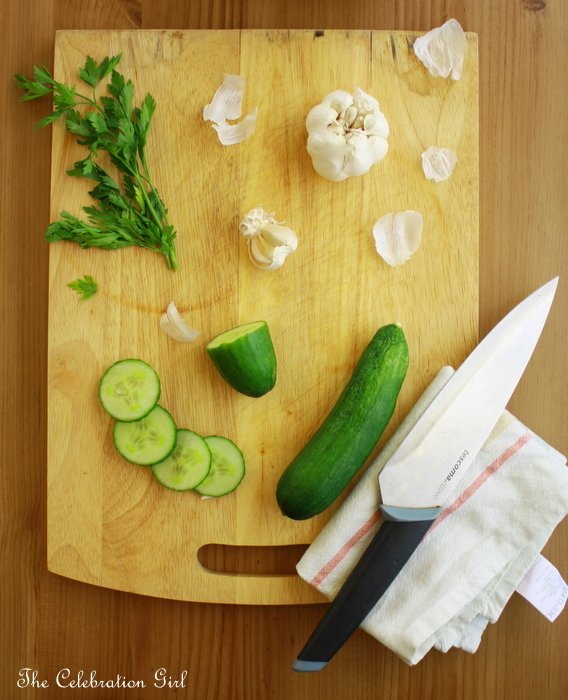
The procedure couldn’t be simpler: Cut the cucumber into thin slices, and then chop them finely. Place it in a bowl. Chop a clove of garlic (or half, if you are not a very garlicky person 😉 and add it to the cucumber. Add greek yogurt (500 ml) and mix well. Chop a few parsley leaves to garnish.
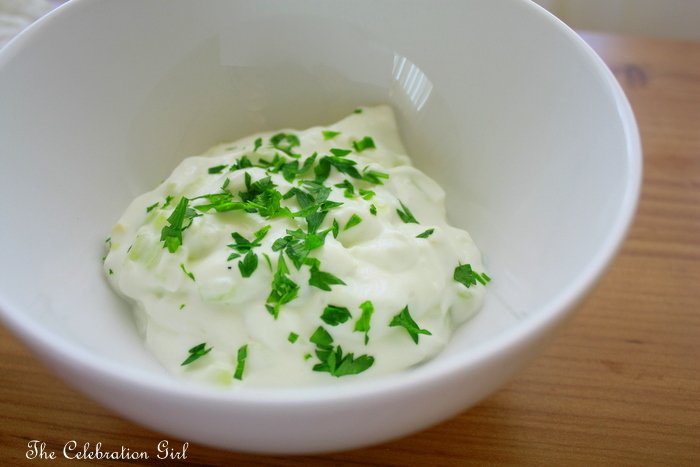
This is the way I learnt to do it from my husband’s family, in Serbia. I should note, however, that here in Cyprus I learnt a different way which is equally delicious but a little bit different. In the Cypriot version they double the amount of cucumbers, garlic is optional, they generally add 2 tablespoons of olive oil and they replace parsley for dried mint. My recommendation: try both!
What’s the weather like these days where you live? How do you cope with it?
Have a lovely Wednesday and see you next week!
by Marcela M. | Jul 19, 2011 | Blog, cookies, Recipe Box, Recipes, Sweets, Uncategorized
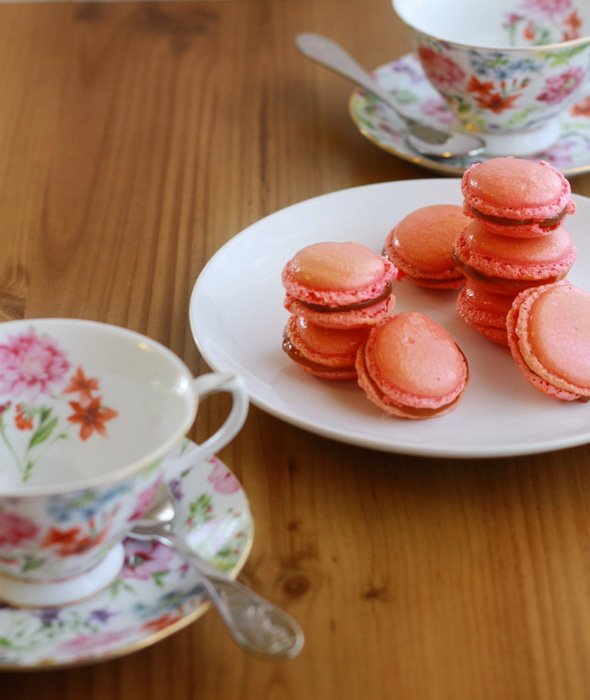
Good morning dear friends! How are you today? I hope you had a fantastic weekend.
I had planned to write this post before but, as you may know, there was an explosion in a munition deposit in Cyprus, that resulted in the destruction of the island’s main power plant. As a consequence of this, and considering that we are in the middle of a torrid summer, power rationing measures have been put in place (no AC, among others), and we are experiencing daily (sometimes twice daily) power cuts. So I guess the macarons that are the object of this post will be the last baking I will be doing for a while – at least until the situation regularizes a little bit- and I will have to reduce my blog posting to one post per week (on Mondays).
I had wanted to make macarons for a long time but, I must confess, I was terrified by the little cookie. I am not a professional baker and macarons are, as a friend put it, the royalty of baking, so I wondered whether I was going to be up to the task. I read countless recipes and instructions on the internet, and there always seemed to be so many steps that one needed to attend to with extreme care and attention, so many things that could go wrong, so many chances that for some unexplainable equation things would in fact go wrong, that I wondered whether making macarons was reserved for some elite of extremely apt bakers while me, a mere muggle of the craft, could never aspire to having these cute and delicious cookies coming out of my oven.
My favorite recipe was the one Linda (from fabulous blog Call me cupcake) shared on Cake Journal. After I read it, I started thinking that maybe I should try. The instructions were detailed, there were plenty of pictures and the commenters kept mentioning how they had been able to make macarons with it. I was encouraged! I bookmarked the recipe and, for several months, I would go back to it every now and then, not daring to actually try it.
It wasn’t until I read the article “Macaron Mythbusters” in Brave Tart that I actually started thinking “I can do this!” If you haven’t read it, please go now, you can continue reading my post later. I just love the humour with which it is written and, being the nerd that I am, its scientific approach to macaron making fascinates me. When I read that “We’re talking about a cookie here, not the Heisenberg uncertainty principle.” I started laughing hard at myself for having been scared of, yes, a cookie and I decided it was time to give macarons a try. The worst thing that could happen, after all, was wasting a few egg whites, almond powder and sugar…and I could always turn a failure into a different kind of success (as I did here). And if I was going to give them a try, what day could possibly be better than July 14th, Bastille day? I am a Francophile, after all 😉
Stella‘s recipe, though, calls for a very stiff and dry meringue, which I was not sure I could achieve with my Moulinex food processor’s whisk attachment (see photos in this post) . Since one of Stella’s Ten Commandments of Macaron making recommends making meringue as instructed by each recipe, I decided to try Linda‘s recipe first (which calls for a stiff meringue, but not necessarily that stiff), while following Stella’s commandments at the same time. I also tested each step according to both their tips, and contrasted textures with Linda’s pictures and with these ones as well. And I am happy to report that it worked! I still have to work on my piping technique, I have to get to know my oven better (I have now bought an oven thermometer for that purpose, yay!) and I have to work on colouring too, but at least I can happily say that my macarons looked like macarons and-most importantly-tasted like macarons!
In case you are interested in giving them a try- and I encourage you to do so, because they delicious!- here is what I did, with pictures to show you every step :
1- I bought ground almonds but, as both Linda and Stella recommend grinding them even more, this is the first thing I did. I put 200 grams of ground almonds (the whole pack) in my food processor and pulsed 5 times.
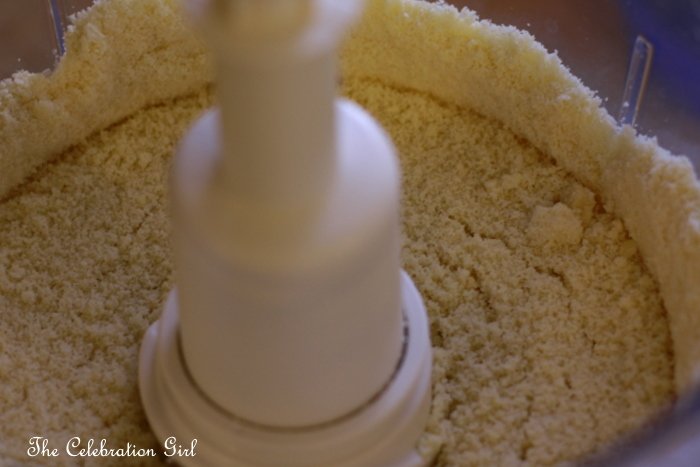
2- I sifted the processed almonds (with a colander, as I don’t own a baking sifter) and this is what I ended up with:

3- Using a kitchen scale, I measured 100 grs of ground almonds (what the recipe requires) and saved the rest for some other time in an airtight container. I put the measured almonds in the food processor again, and measured (also with the scale) the required amount of powdered sugar. I added it to the almonds and processed everything for 1 minute. This allows for them to be properly mixed together, and also to break any big lumps there may be (which is necessary for good macarons).

4- I then sifted the dry ingredients twice, and set them aside.
Now it was time to make the meringue! Stella explains that a good macaron requires a stiff meringue so that, once the dry ingredients are added to it, they will have time to be incorporated without the meringue deflating too fast and therefore losing the necessary consistency for macarons to keep their shape. If the meringue is not stiff enough, there is a risk of overmixing the macarons. It is for this same reason that she recommends adding food colouring while making the meringue and not when adding the dry ingredients: this guarantees that the colour will be fully incorporated without compromising the batter’s consistency. So this is what I did.
According to Stella’s mythbusters article, there is no need to age the egg whites for making a good macaron. Linda, however, recommends aging them for 24 hs and, since I was following the latter’s recipe, I did (in case you don’t know what aging an egg white means, I should clarify that what is required is for you to separate the egg whites, to keep them covered with a paper towel in the fridge for 24 hours, and to take them out of the fridge a few hours before using them. You can also keep them at room temperature, if your weather conditions so permit without them getting spoiled).
5- I washed my food processor and made sure that there was no grease in it by cleaning it with a little bit of lemon juice and a paper towel. I then added my aged egg whites and started beating at medium speed.
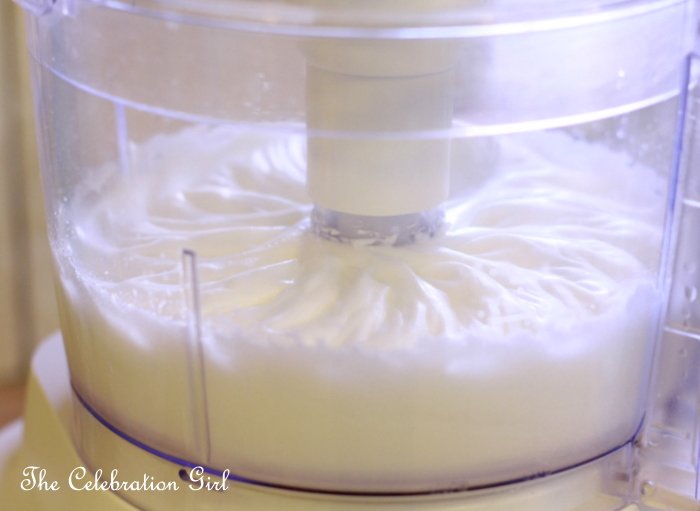
6- When the egg whites started foaming, I added the ground sugar, one tablespoon at a time.
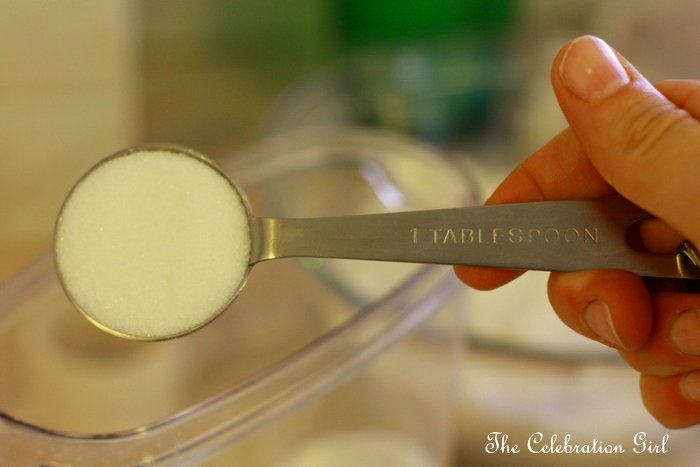
7- Linda’s recipe asks for a glossy and stiff meringue that won’t slide from the bowl if we put it upside down. I tested the consistency with a spatula (as you can see from the picture below, it doesn’t move)
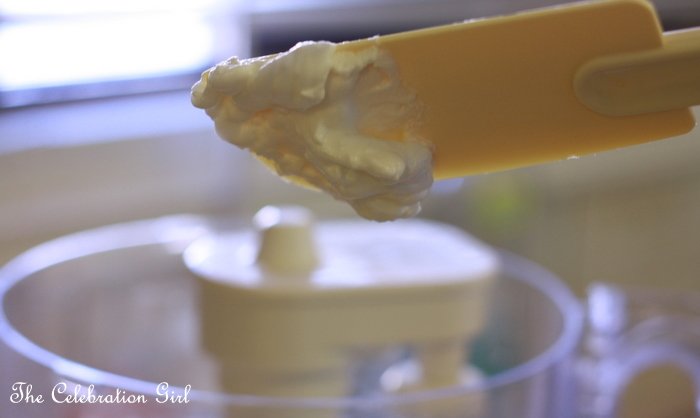
8- I added gel food colouring with a toothpick, and I continued beating for 2 more minutes, until all colour was evenly incorporated. I was looking for a soft shade of pink – I will have to add less the next time!
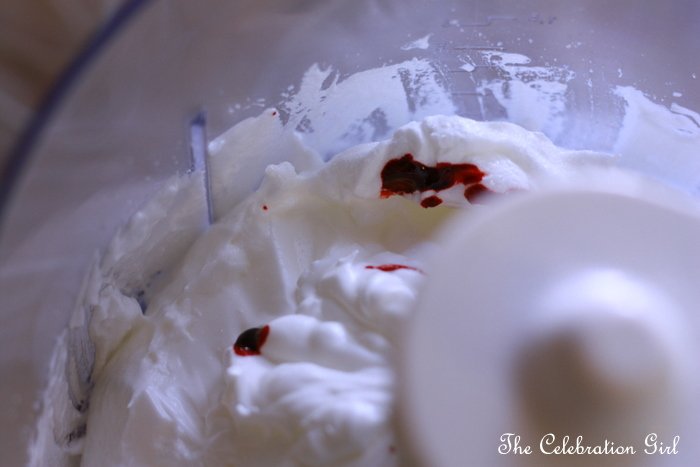
9- To my surprise, I ended with a stiffer meringue than I expected (yay! Go, Moulinex, go!). This is what it looked like when I put it into the mixing bowl:
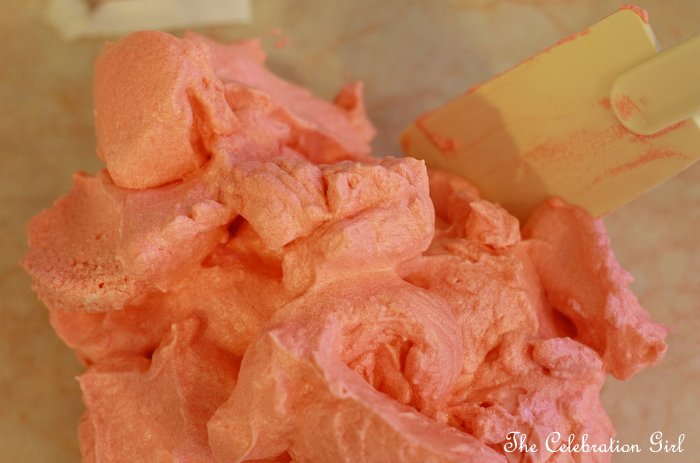
10- I added the dry ingredients all at once, and started folding using a spatula. This is called macaronage, and most recipes I have read mention that it takes around 40 strokes to achieve appropriate macaron consistency. They all agree too in that a slightly under-mixed batter is better that an over-mixed one, so I made sure that I tested the consistency every 3 strokes to make sure I did not over do it. Stella recommends making sure that one scrapes the bowl from all sides several times , so I did this too (see the reasons for this here). I counted the strokes and it took me 44 (ah OCD ;))
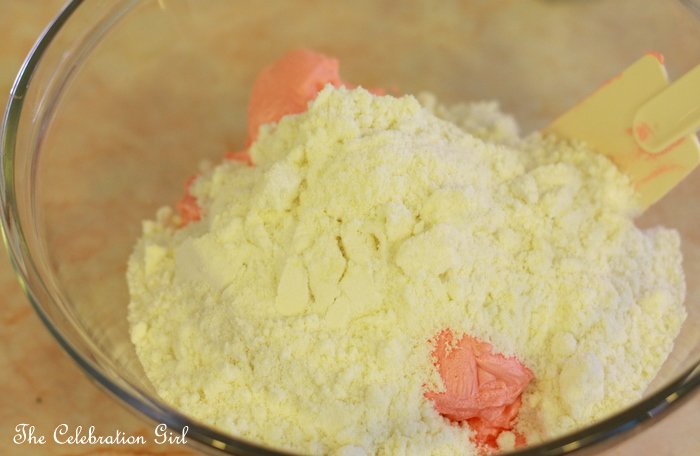
11-I tested whether the batter had reached appropriate consistency by checking whether the mixture flowed like a ribbon when holding the spatula over the bowl (as Linda recommends, and as seen below). I also used Stella’s method of spooning some batter out and putting it back into the mix and checking whether it incorporates into it within a few seconds.
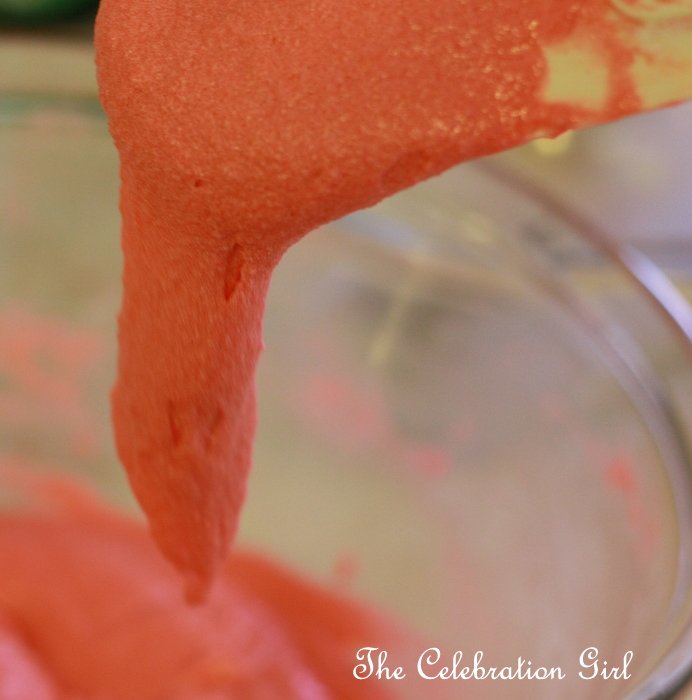
12- I filled my pastry bag with the help of a tall glass and started piping the macarons on a baking sheet covered with baking paper.
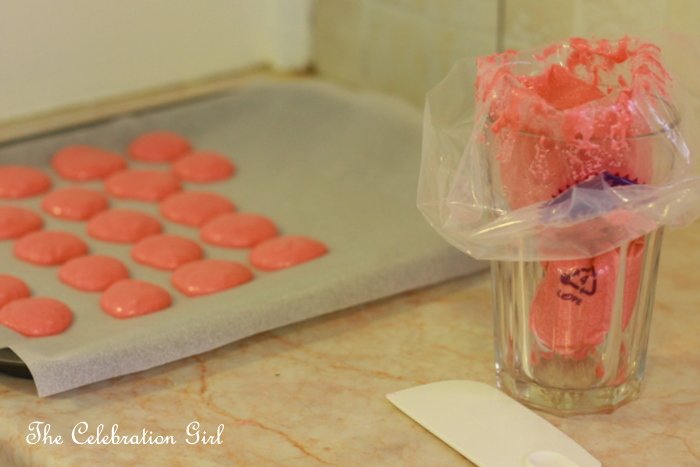
Now, this is where I made the mistake of piping them too close to each other because I had no idea how much they were going to spread. So, bear in mind that they do spread a bit and that , even if they look nothing like beautiful circles at first, they will look better once they finish spreading (just a few minutes). So give them some room to get a nice round shape, so that once they are in the oven they can grow nicely and so that you don’t have to separate them with a knife once cooked (ouch!). Also, try making them about the same size because you will have to pair them afterwards!
The second sheet I piped turned out better than this one, but I am adding the picture of the first one so that you can learn from my mistakes and see what NOT to do:
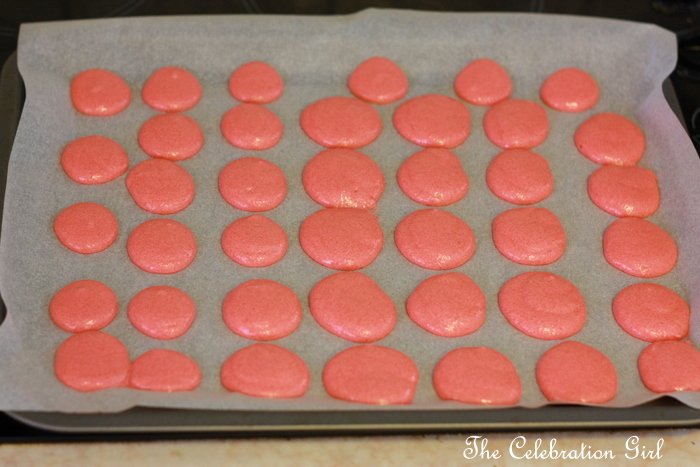
13- I tapped the baking sheet against the counter (as Stella recommends) and then let them sit for 2 hours (as Linda’s recipe requires). This was easy to do because we had a power cut just then and I couldn’t put them in the oven immediately even if I wanted to 😉
When the power came back, I turned my oven to 150 degrees celsius (or so I thought) and put the first sheet inside. I said “so I thought” because it took me much longer to cook the macarons than the recipe called for. This could also have been because of the addition of food colouring but, in order to be sure the next time, I have now bought an oven thermometer and I am planning to calibrate my oven before making them again.
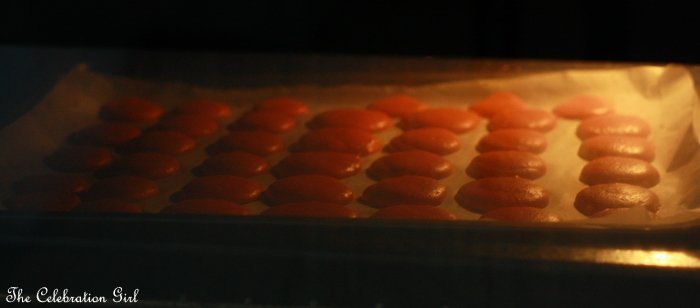
In order to know whether they are ready or not, try separating them from the baking sheet. If when you try to take one, the top comes off and the bottom remains attached to the sheet…well, they are not ready. Also, their interior should not be gooey.
This is what they looked like when I took them out of the oven, while they were cooling down.

14- After they cooled down completely, I assembled them. I must confess I used what I had in the fridge as a filling: home made dulce de leche and chocolate ganache. I let them rippen for 24 hours in an airtight container in the fridge before eating them (except for one, for testing purposes and for the sake of science only ;)). They do taste much better after 24 hours, so don’t eat them right away (not all of them at least!)
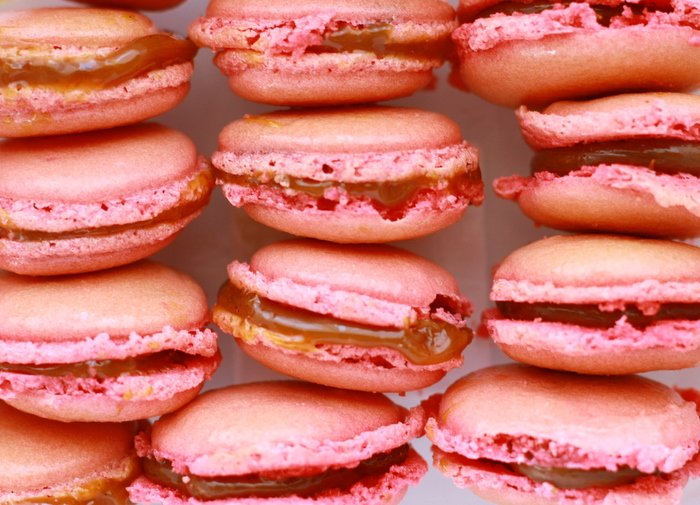
Now that I have made them once, I can’t wait to make them again and to experiment with new flavours and colours!
Would you like to make them?
Have a nice week and see you again next Monday!
by Marcela M. | Jul 12, 2011 | Blog, Cooking basics and tutorials, Marmalades and jams, Recipe Box, Recipes, South America, Sweets, Travel, Uncategorized
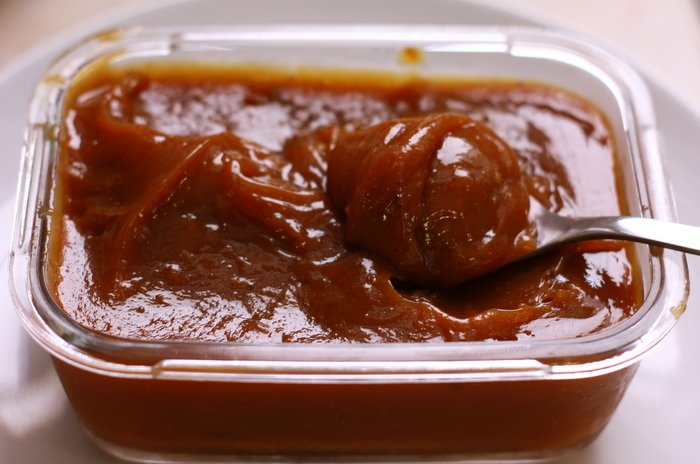
Happy Tuesday dear Friends! I hope you had a wonderful start of the week.
In this past post I talked to you about dulce de leche, and I mentioned that this milk jam is the traditional filling for cornstarch cookies or alfajores de maizena. After the post, a few friends asked me how they could make dulce de leche, because they don’t live in countries where one can simply go and buy one jar at the supermarket.
So here I am, showing you three easy ways of making your own, the Argentinian way. Why the Argentinian way? Because you can find different versions of the same product pretty much all around Latin America, but if you read the components you will notice slight differences in the ingredients. For example, while in Argentina dulce de leche is made 100% with cow’s milk, traditional mexican dulce de cajeta is made with goat’s milk; and in Uruguay it generally includes cornstarch (which makes it thicker). It is also possible to find it outside of Latin America, for example in France (where it is called confiture de lait), in Israel (ribat jalav) and, I am told, even in India.
So how can one make dulce de leche, when it is not readily available for purchase?
There are three ways I know of, but only two of which I have tried:
I- By submerging a can of sweetened condensed milk in a pan full of water, and letting it boil for about 3 hours (in a normal pan) or 45 minutes (in a pressure cooker). If you use this method, you should remember that:
a) The can has to be completely covered in water at all times, otherwise any part that remains uncovered will not mutate into dulce de leche (as in the picture below)

b) Once the 3 hours have passed, make sure that the can is COMPLETELY cooled before opening it. If you open it when it’s still hot, the content will burst and there is a serious risk that you may burn yourself. So wait. Put in the fridge for faster cooling if necessary. But do not open it immediately!
This is what will be waiting for you when you open the can:
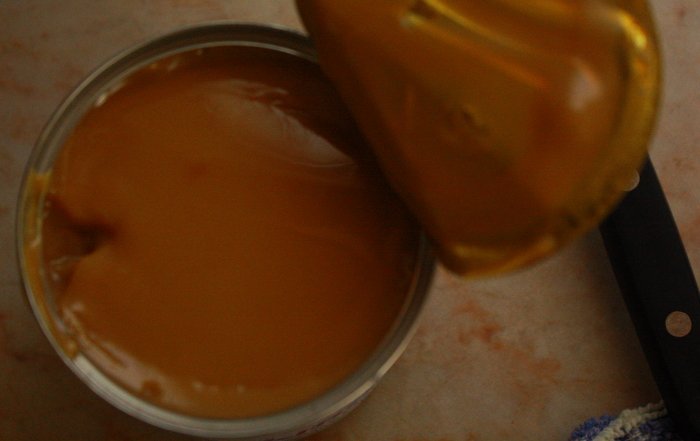
II- If the possibility of burning yourself scares you a lot, you can try Chef David Lebovitz’s method, which consists of baking sweetened condensed milk au bain marie, covered in aluminum foil. I haven’t tried it, but it does look like a safer option, and it takes less time than the original can version.
III- Make dulce de leche from scratch. It is not difficult to do so, and, though it is a bit time consuming because you need to watch it carefully, it is worth it. I must admit that, when I lived in Argentina, I didn’t do it very often, because there are so many good brands available that I didn’t see the point. But one day, when I was 21 years old, my father (who loved to cook) suggested that we tried, so we asked around for a recipe and we made our first batch of dulce de leche. This is the recipe I will share with you today.
To make 1 kilo of dulce de leche, you will need
– 5 litres of milk
– 1 kilo of sugar
– 1 vanilla pod (if you don’t have vanilla pods, you can use 1 tablespoon of vanilla extract)
– 1 tablespoon of bicarbonate of soda
– 1 big pan
– 1 wooden spoon
The preparation is very simple.
1- Put the milk in the pan. Make sure the size of the pan is twice as big as the amount of milk, because the preparation will rise once you add the bicarbonate of soda and, if it is too small, you run the risk of it overflowing the pan and making a big mess. In order to prevent this, I am told that one should put in the pan a few small glass balls (like the ones children play with), because this will prevent the preparation from rising too much.
2- Add sugar, all at once.
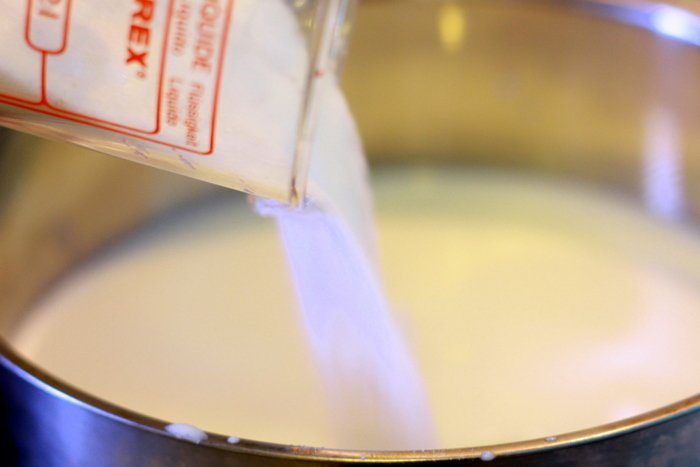
3- Stir the preparation and bring to the boil. Let it boil for 5 minutes, stirring constantly
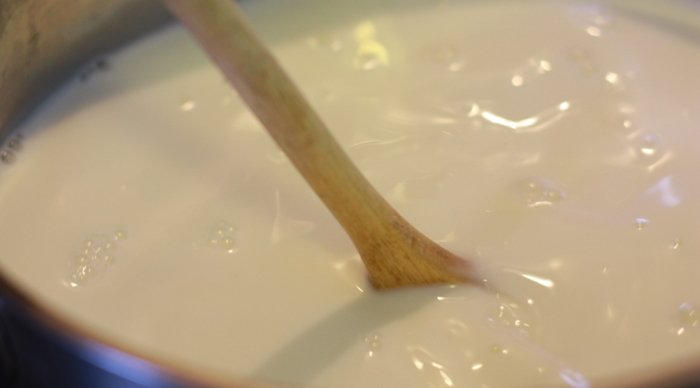
4- Bring heat to the minimum, and add the vanilla pod and the bicarbonate of soda (I added 1 teaspoon because I was making half the preparation only)

5- Let the preparation boil at minimum heat, stirring every 10-15 minutes. It should look as in the picture below:
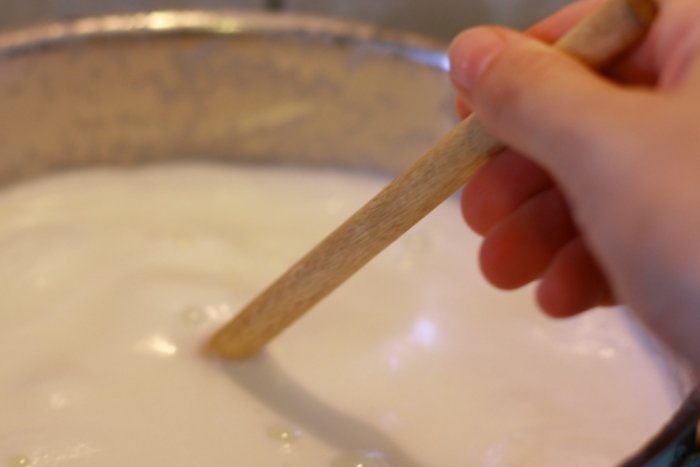
6- After about 1 hour, the milk will start to brown, and will look like this:
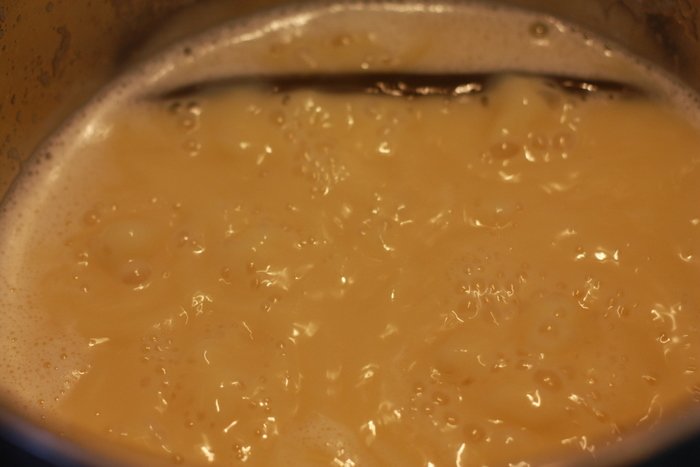
7-After another hour, it will become even darker, like this:
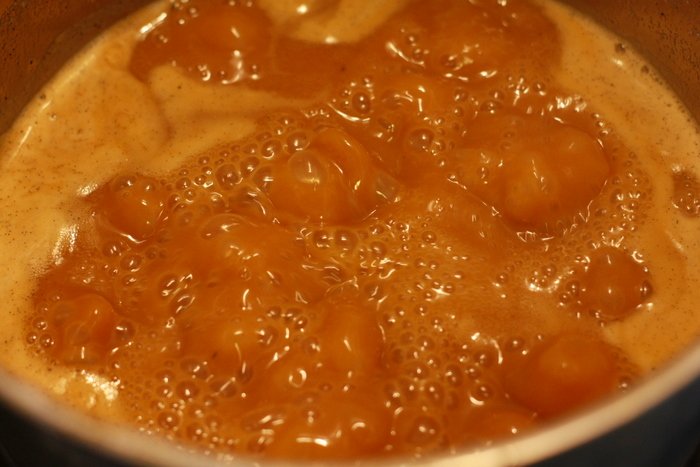
8- After around 1/2 hour, it will be thicker and darker and it will have considerably reduced. When it reaches this point, start stirring constantly for about 15 minutes.
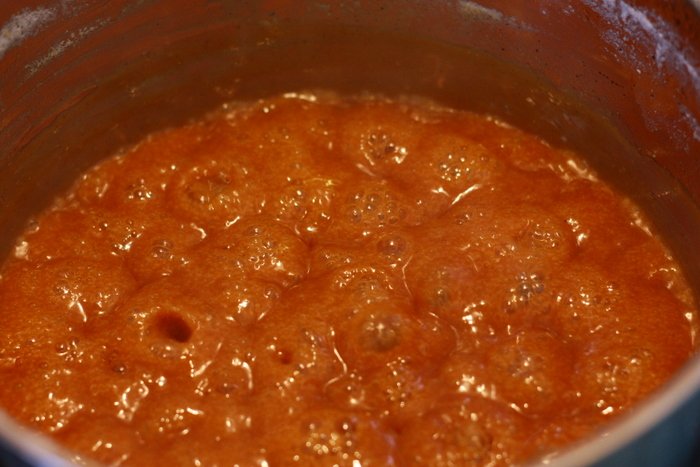
This is the consistency it had at that point. It doesn’t look like it’s ready but, trust me, it almost is.
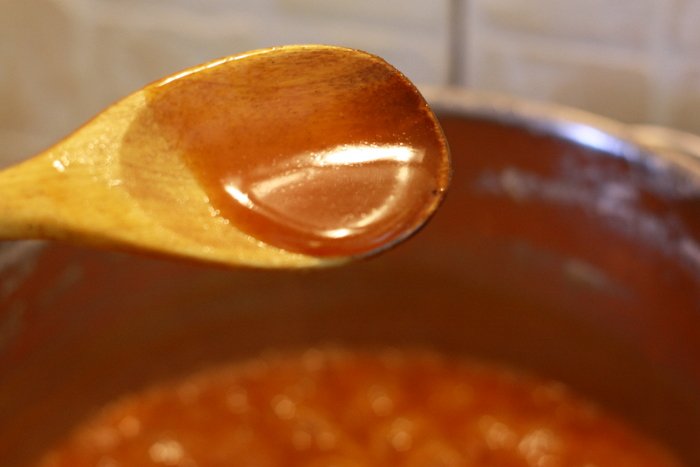
9- After 15 minutes, turn off the heat and continue stirring for another 5-10 minutes. What I like to do then is to transfer it to another pan (it cools faster). This is how it looked right after I transferred it:
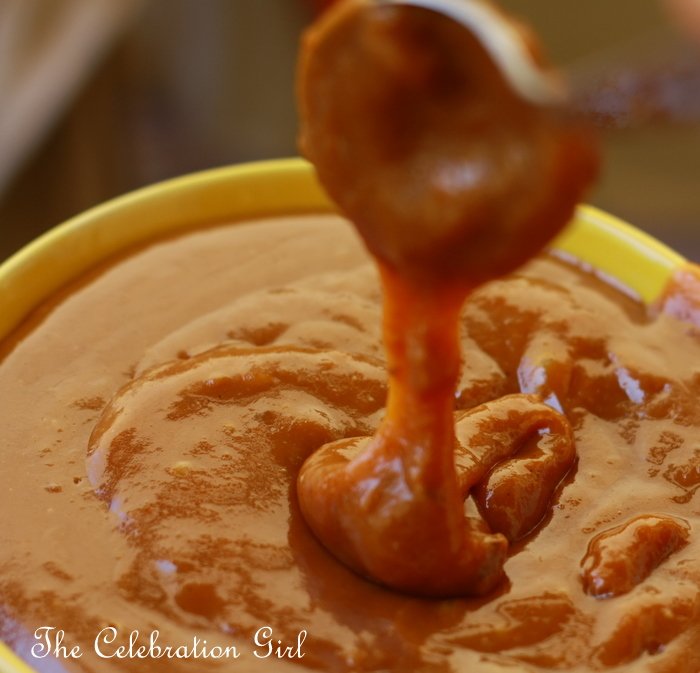
As you can see, it still looks quite liquid, like a caramel sauce.

But all it needs is to cool down completely to reach the appropriate consistency.

10-Once it has cooled down, transfer it to a glass container and keep it in the fridge. This is how it will look after 3 hours in it:
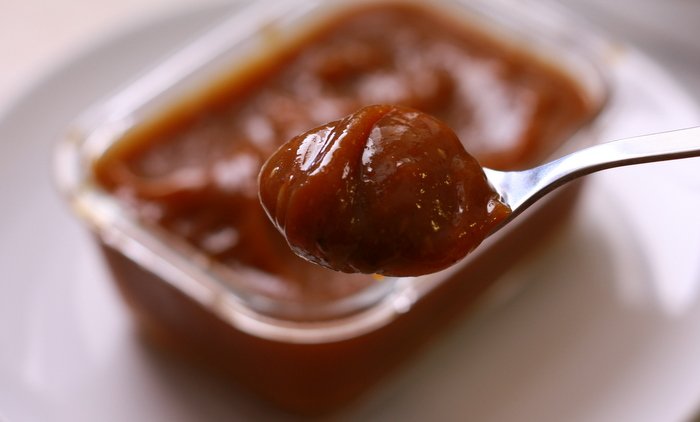
Ready to eat and to add to preparations such as cookies, cakes, brownies, ice-creams, puddings, and so many more!
I hope that you will like it if you decide to make it.
Have a wonderful week!
If you want to know how to make dulce de leche repostero (baking dulce de leche), check this post



















































